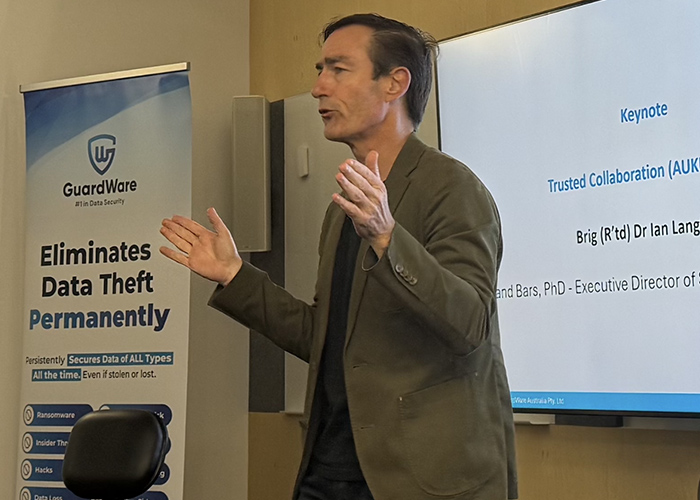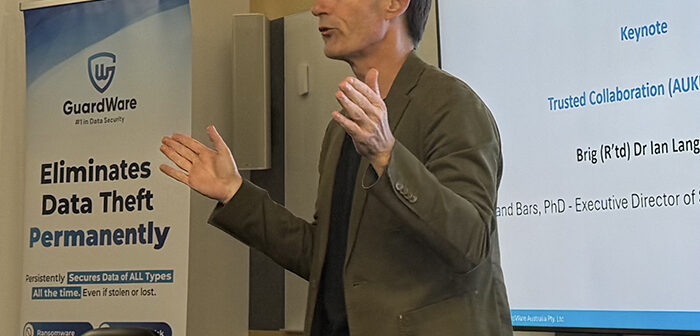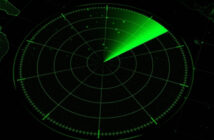
Edited: Chris Cubbage, Australian Security Magazine
Australia’s national security landscape is in a period of profound transformation, marked by the convergence of military modernisation, technological acceleration, and strategic uncertainty across the Indo-Pacific. Addressing these themes head-on, Brigadier (Retired) Dr Ian Langford delivered a compelling keynote address on “Trusted Collaboration” and offered a candid assessment of Australia’s place in an increasingly securitised world.
Dr Langford was speaking at the Securing Australia’s Defence Research Seminar at UNSW Kensington, an event supported by the UNSW Defence Research Institute and included a product release by sponsor GuardWare, a timely example of industry and academic collaboration as part of Defence Trailblazer.
Langford, a former senior Defence leader and now an academic and policy thinker with Security and Defence PLuS, framed his remarks around the “securitisation of national power”, the idea that every dimension of Australian society, from critical infrastructure and data systems to supply chains, academia and diplomacy, is now part of the broader national security equation.
“War,” Langford noted, “has re-emerged as an instrument of national power. The use of violence to achieve political outcomes is how the system works, and it never really went away.”
The Davidson Window and Strategic Reality
Langford revisited Admiral Phil Davidson’s testimony to the U.S. Congress, which identified a potential “Davidson window”, a period between 2025 and 2027 when the People’s Republic of China may possess the military capability to forcibly unify with Taiwan. For Langford, the concept underscores a larger truth: the return of great power competition as the defining feature of our era.
He reminded the audience that while Western nations believed the “peace dividend” following the Cold War would last, others, notably China, never lost sight of history. The shift of the world’s geopolitical centre from the North Atlantic to the Indo-Pacific means Australia must confront an enduring question: Do we seek security in Asia, or from Asia?
AUKUS as a Catalyst, Not a Contract
Central to Langford’s analysis was the AUKUS partnership, announced in 2021 between Australia, the United Kingdom and the United States. While often reduced in public discourse to nuclear-powered submarines, Langford stressed that AUKUS represents something far larger, a national and industrial transformation designed to make Australia “a bigger version of itself.”
“Pillar One,” he explained, “is not just giving Australia an undersea capability. It’s recognising the world as it is, not what we think it should be.”
Langford described AUKUS as an ecosystem of trust and collaboration spanning government, academia, industry, and defence. He argued that leadership across these sectors must evolve, not through rigid hierarchy, but through shared responsibility and initiative. “We’ve got leadership, but no one’s in charge,” he observed. “And that’s not a criticism. It’s an opportunity.”
Workforce and Trust: Australia’s Strategic Challenge
Among the most pressing challenges is workforce development. The sheer scale of technical expertise required to deliver on AUKUS, from nuclear engineering to advanced manufacturing, dwarfs Australia’s current capacity.
Langford cited the Australian Defence Force Academy’s roughly 400 engineers in training and contrasted that with the tens of thousands of skilled personnel required for the submarine enterprise. The answer, he argued, lies in unlocking the latent capability within Australia’s universities.
Yet there are institutional barriers, particularly around security clearance for students from diverse backgrounds. Langford described this as a national problem requiring reform, not a failure of individuals.
“It’s not for the kids coming through to navigate their way through the system,” he said. “It’s for us to make the system fit for purpose.”
He proposed mechanisms like an AUKUS skills-based visa between partner nations to enable mobility, knowledge sharing, and talent development, a practical manifestation of “trusted collaboration.”
Pillar Two: Technology Asymmetry and the Quantum Frontier
Langford emphasised that AUKUS Pillar Two, focused on emerging technologies, represents the “asymmetry” or strategic offset that could define future conflict. This includes quantum computing, artificial intelligence, hypersonics, electronic warfare, and autonomous systems.
Drawing parallels with past Australian innovation leadership, from CSIRO’s invention of Wi-Fi to UNSW’s breakthroughs in photovoltaics, Langford urged academia and industry to seize the opportunity to lead in quantum and related technologies, rather than waiting for government direction.
He underscored that these advances are not hypothetical: “It’s less about whether or not they have the technology, and more about the convening power of the narrative around capability.”
Lessons from Ukraine and Local Realities
Langford drew lessons from the ongoing war in Ukraine, particularly the transformation of drones into consumable assets rather than controlled stores, a model that challenges traditional military procurement. However, he warned against simplistic parallels, noting that Australia’s vast distances and maritime geography demand distinct applications of emerging technologies.
Beyond Submarines: Building a Bigger Australia
Langford returned repeatedly to his central theme — that Australia must envision a “bigger version of itself.” Whether in defence, data infrastructure, or energy policy, national security now requires integrated thinking across sectors.
He linked data sovereignty and energy generation directly, warning that without adequate power capacity, Australia cannot hope to secure or process the data critical to modern security and commerce.
“Data,” he said, “is about putting electricity in and getting information out. It’s power, people, and infrastructure, not computers.”
This, Langford argued, is where AUKUS can drive holistic national renewal, in workforce, industry, and innovation; much like Singapore’s transformation in the 1960s.
Interchangeability and the Future of Allied Defence
In response to questions on AUKUS interoperability and the emerging doctrine of “interchangeability,” Langford explained that true interchangeability means seamless operational substitution between allied forces, from ships to aircraft to systems.
“When an Adelaide-class checks out and an Arleigh Burke-class checks in, the commander shouldn’t know the difference,” he said.
For Australia, this means designing systems, supply chains, and research partnerships that function as integral parts of a collective allied defence capability.
A Call for Trusted Collaboration
Ultimately, Langford’s message was both pragmatic and aspirational. Trusted collaboration, he said, is not a slogan, it’s a national project requiring openness, leadership, and courage across every sector.
“Don’t fall into the trap of thinking AUKUS is just about submarines,” he concluded. “This is about making our country a bigger version of itself, together.”
Langford’s briefing provided a sobering but optimistic vision: one where Australia’s security and prosperity depend not on isolation or dependence, but on trust, the trust to collaborate, to innovate, and to lead.






